by Pablo Arriaga
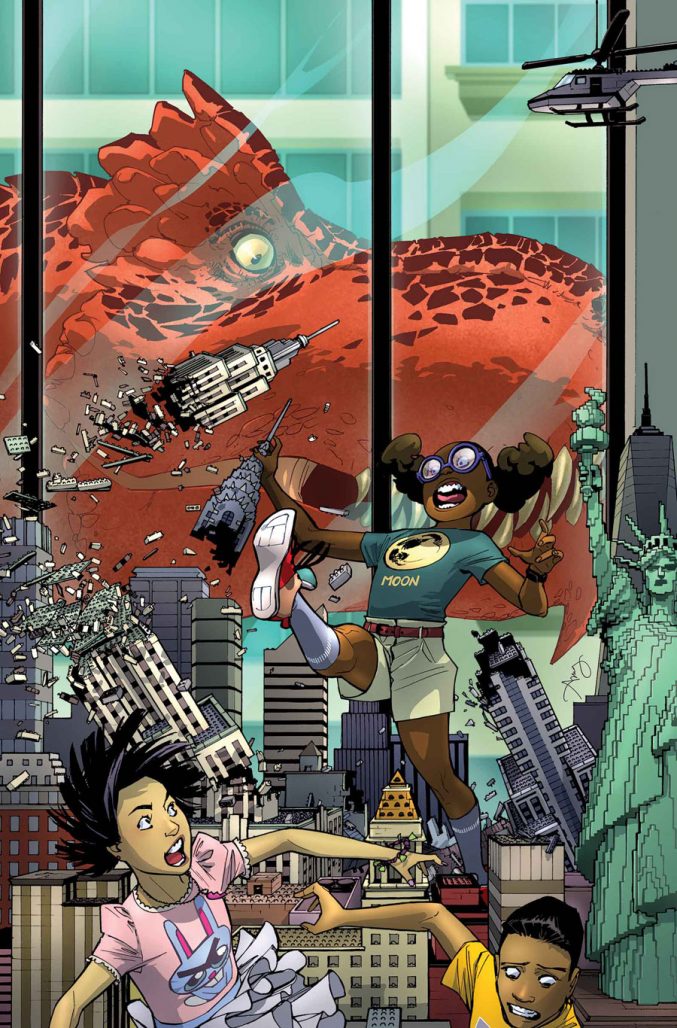
Natacha Bustos is roaring onto the comics scene with her artwork on Moon Girl and Devil Dinosaur. The series, which is now in its second arc, focuses on a young black girl named Lunella Lafayette. She’s a precocious genius who feels trapped by her mundane school life and her inhuman gene, but when she meets the prehistoric time-traveling Devil Dinosaur, her whole world is turned upside down.
Moon Girl and Devil Dinosaur is co-written by Amy Reeder and Brandon Montclare, the team behind Rocket Girl and Halloween Eve, and has become a slam dunk hit over the course of its first seven issues. The eighth, which is out today, features the return of Bustos on art after a one issue break. It’s a welcome homecoming, as Lunella’s world is fully realized by Bustos’ synesthetic knack for visualizing sound, butter smooth linework, and zany character designs.
Recently, Bustos sat down with The Beat to talk about her influences, her work on Moon Girl and Devil Dinosaur so far, and where she hopes the series will go in the future.
Pablo Arriaga: I was reading that you were introduced in comics by reading manga?
Natacha Bustos: I’ve been into comics since I was little. There were superhero comics here [in Spain], but their themes were mostly aimed towards a more masculine audience. As a girl, that wasn’t very appealing.
Instead, anime and manga arrived when I was about eight or nine years old and I got into that. From those shows and books I started getting into the Japanese aesthetic and style of drawing– that’s how I absorbed a lot of things. Some of the first tomes I bought were Dragon Ball and Rumiko Takahashi books– I read a lot of Ranma ½. I was born in ’81, so I was a teenager in the 90s and Marvel and DC comics were…very different then. The only one I read was X-Men. That book drew my attention because the characters were a team that included women. I loved the types of adventures they had, especially in the animated series.
Arriaga: Anime and manga definitely exploded in Spanish speaking countriees during the 80s and 90s.
Bustos: Yeah. All the animation we watched here in Spain was dubbed in Latin America,. We have assimilated their voices from the cartoons of our childhoods. He-Man and Knights of the Zodiac (Saint Seiya) had original Mexican [voices] until the 90s. After that, they had Spaniard voices in Spain– it was very interesting.
Arriaga: What are your influences?
Bustos: Well as far as comic influences go, [in Spain] you inevitably see a lot of European comics, since France is next to us and Spain publishes a lot of European trades; they publish a lot of Moebius, in particular.
During the 80s and 90s there was a Moebius boom in Spain. There was a magazine called CIMOC, which was a monthly magazine where they compiled stories as chapters. All of Moebius’ famous works were compiled by CIMOC. Back when I was a teen, his stories didn’t reach me as much because they were more adult, but the drawings were brutal and I remember observing his techinique and copying the way he inked sometimes from my cousins who bought his books. It was prodigious.
I would also read some Astérix & Obélix as well as a lot of classic Tintín. More recently, in the last decade I have enjoyed a lot of graphic novels from Fantagraphics by people like Charles Burns and Dan Clowes. They adore them here as cult comics artists.
I haven’t read much classic super heroes– I stray towards more adult stuff, you know? However, I have read work by Frank Miller, Alan Moore, and Michael Gaydos. From reading them I was able to learn about Jack Kirby, who’s always fascinated me. When I was selected to do Moon Girl and Devil Dinosaur, I thought “My. God. Devil Dinosaur?! Is this real?” I’m a big fan of the way he draws– it’s very powerful.
I own a lot of graphic novels too. That’s what I like to buy and read a lot of. I also have a lot of Japanese manga (laughs). I recently got Lupus– I’m not sure that arrived in the United States yet.
Arriaga: I believe so.
Bustos: It’s from Frederik Peeters. It’s a compilation of about four or five trades of 68 pages– it’s big but people here like trades. Let me get up a second.
>>At this moment of the interview, Natacha stood on her chair and started to rummage off-camera to look through what I think was a bookshelf full of books and graphic novels. <<
People in Spain buy larger books like this. When I say people, I mean those who aren’t habitual comics readers. Personally, I like everything. I like superhero comics or what we call “staples,” I like European comics, I like manga, and I like everything I can get myself hooked on. The strength of a work commands interest more than where it’s from.
Arriaga: How did you come to work on Moon Girl & Devil Dinosaur?
Bustos: I met a DC editor named Greg Lockard in Barcelona. There is a comics convention here called FICOMIC, and like any Comic Con, you get the opportunity to meet foreign editors. You have the chance to get interviews, show off your portfolio, and talk to the professional editors to see whether or not you might have professional opportunities and get advice for improvement.
So, I ended up meeting with this DC editor and he said “there’s potential here, I will try to get you onto something.” After several months, he said he had something for me. He asked if I was interested in working on a story for Strange Sports Stories called “Going to Nowhere” with Brandon Montclare. I said of course!
After we made that work together, I think Brandon must have talked about me when they were in initial stages on Moon Girl. At the time, I was helping Javier Rodriguez on Spider-Woman. Javier gave me the chance to participate on issue #10 as a fill-in and the plan was to continue doing fill-ins with Javier. Then, [Marvel] wrote to me and asked me if the project interested me, and of course I was mesmerized. I was thinking “My God. This is amazing!”
Arriaga: Howdo you like working with the team?
Bustos: I am very happy working with this team! I’m very happy with Amy and Brandon, their work dynamic is incredible and I see them sometimes in videos they record and they’re such a fun and hilarious pair. I’m learning so much with Amy Reeder. She’s an amazing artist and I didn’t expect that I would be working with her. There isn’t anything by her being published in Spain, but I read Rocket Girl and find her drawings incredible! I’m already campaigning for Rocket Girl to make it to a publisher.
I have a very good working relationship with my editors Mark Paniccia and Emily Shaw. I don’t have a lot of experience with editors, but I’m very pleased and surprised about how great it is to work with them. Tamra Bonvillain is a crac* of colors. Mark hit a perfect bulls-eye when he chose her to be the colorist for the series. It’s clear how they see a drawing that resonates with a color style and they find the right colorist.
Marvel knows how to put their teams together. We’re generally happy and hope to continue like that.
Arriaga: Has Moon Girl & Devil Dinosaur been a big change for you?
Bustos: I’ve been making comics for about five or six years, but also always had other illustration jobs like advertising, working in an office, drawing backgrounds for animation studios, and making concept art for characters that are not mine. All these projects and teams have a very different rhythm to the one I have when I work on comics. I haven’t been able to fully dedicate myself to comics until now, so that’s the most important change to me– to be able to completely focus on something I’ve been fighting for so many years.
There is no comics industry in Spain and it’s very hard to break in from here. I feel very fortunate and have learned so much in so little time working for Marvel. I also like being a part of the community of artists in Spain who work on US books, like Javier Rodriguez who lives [in Barcelona]. I see him often. There’s also Kano who works for Valiant, Fernando Blanco, and David Lopez.
I also talk to people online. I met Emma Rios when I published my first comic eight years ago and we stay in touch digitally. I can’t believe that I’m now working at Marvel and that her and I have become references to female artists in Spain. It gives me a lot of hope to be part of something. Seeing my work recognized feels really good.
Arriaga: The conversation now is about finding diversity in gender and race in comics. What’s your opinion on it? Particularly with a character like Lunella Lafayette.
Bustos: I think it’s so important to find relatable characters like Lunella in comics. It’s something I missed a lot when I was a child. It was hard to find and read works where females weren’t objects because it happened so frequently in superhero comics. That pattern made it very hard for me to connect with books as a girl– less as a teen then as a woman.
A character like Lunella has been like a “before and after” in my career. I am so grateful to have this; I feel very fortunate. I would have never believed ten or even two years ago that I would be able to make a character like me. The feeling of having done so is like… f@*ck, you know? (laughs)
Arriaga: Do you have any other projects you would like to make?
Bustos: Well right now I’m just getting started, I’ve been working with Marvel for just over half a year now. I can’t say I would like this or that because life takes many turns and you never know where things could go. I’m not saying I don’t have any projects– of course I do. I actually had a project in mind that I started developing before Marvel and DC, but I didn’t know where it would go or when it would be released. I’d like to to continue with Moon Girl & Devil Dinosaur, trying things and continuing the second arc of the story. I’ll see how things are going and make some projects on the side. Thanks to Moon Girl, I’ve gotten some calls to draw covers for Boom!
Mostly though, I’m just enjoying what I’ve got now.
Arriaga: What do you see in the future for Moon Girl & Devil Dinosaur?
Bustos: I wish the best possible future for it and for Marvel to take good care of her. I think she’s a very special character and needs a lot of support. It may not be a top selling title because it’s a new character, recently established, and completely different from what a stereotypical Marvel superhero is, but the type of story that Amy and Brandon are making is fascinating to me. I’m pleasantly surprised that Marvel has bet on Moon Girl and Devil Dinosaur and shown support for a character with a sensible and emotional story.
I see Lunella’s story as a Ghibli one because of the deep feelings and relationships it has. It’s not without action– there is a lot of action in it and it’s a lot of fun– but the most important aspect is watching how Lunella grows up. I wish her the best and hopes she gets to make appearances with other characters like Ms. Marvel. She was with the Hulk and it was a lot of fun.
Ultimately, she is a character with a lot of potential. I see a lot of possibilities and I’ll buy any comic she’s in, definitely.
Arriaga: I’ve noticed you pay a lot of attention to backgrounds. They’re very distinctive in your artwork. Are these backgrounds described in the script, based on references, or do they come from your mind?
Bustos: It’s a little bit of everything. Sometimes [Amy and Brandon] will give me a reference. They’ll tell me the scene is set underneath Manhattan bridge and send me photos. Then, I’ll get on Google maps and look around the area. I know New York through Google Maps, but I haven’t been there yet. I think I could get to places now because of Google Maps and other internet references. Photos have taught me about the city a little.
It’s very curious to see details and pieces from the city such as lamp posts. The types of lamp posts that are on the Lower East Side have those adorning irons on them that others don’t. Using little things like those posts and traffic lights are like finding the pieces to a puzzle that make a recognizable background.
Arriaga: You have another titles like Lolita, which is a French work, and Chernobyl Zone. Is there a possibility to see those published in the States?
Bustos: Chernobyl has been translated to English in England, so if there was any publisher interested, there wouldn’t be much to translate to begin with. I did that book eight years ago to start another project and I consider it more as work for hire than mine because I worked under very strict parameters of style and narration. I couldn’t say it’s my work other than having participated in the visual aspect and I don’t think it’s very representative of my style.
In regards to Lolita– in France it’s very common to make full tomes with artists who have similar styles to the original author. A lot of people have channeled Goscinny’s style into new works of Astérix & Obélix. This is very different to what happens in United States where a series could be ongoing, but it will switch artists and artistic styles. This is especially common with superhero comics.
Javi (Javier Rodriguez) and I share a similar realistic style that has a little cartoonish flair, and since Lolita was a type of manga experiment, he offered me the chance to finish his last chapter. To me, it was great because it was a whole experience to make a complete tome of 180 pages, and the idea was to work the way they do in Japan– very simple with strict deadlines. I did two pages a day to finish on time and that dynamic was reflected in the final tome.
Arriaga: Will we be able to see you at NYCC?
Bustos: I would really like to go, let’s see how I’m doing with deadlines and dates. I will definitely try!
Moon Girl and Devil Dinosaur #8 is out today! The first trade paperback of the series, which collects issues 1-6, is out today as well!


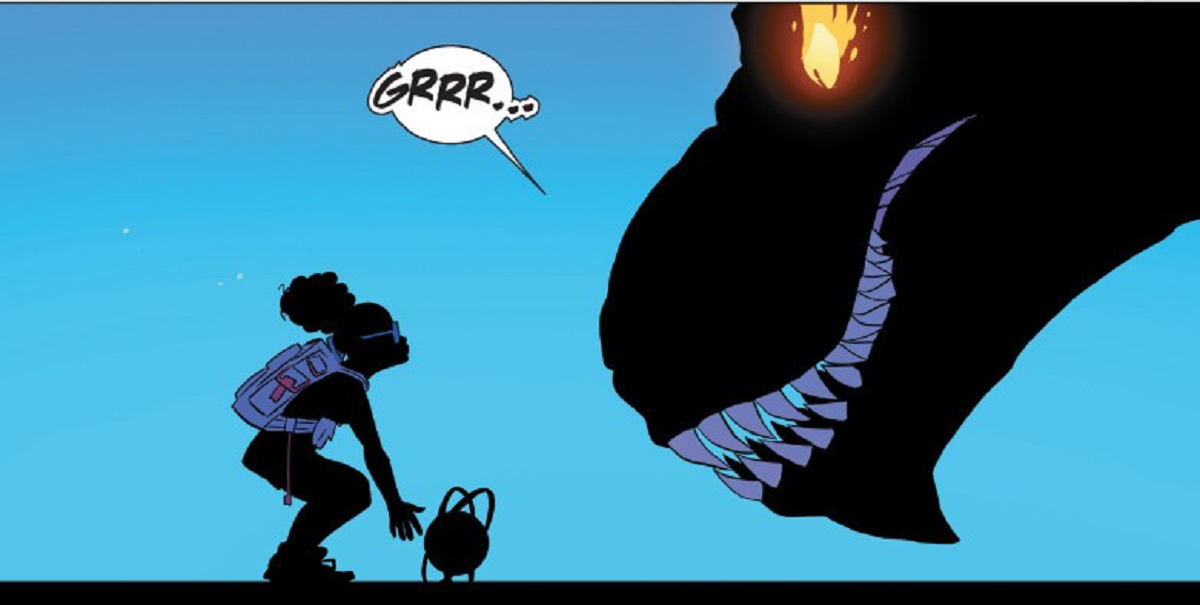
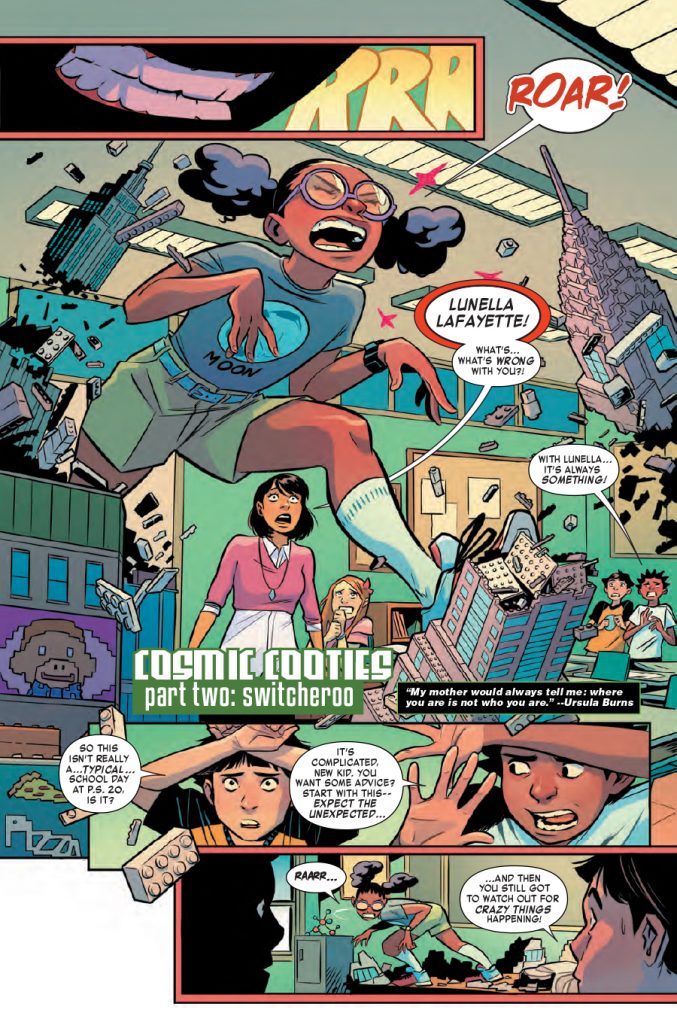
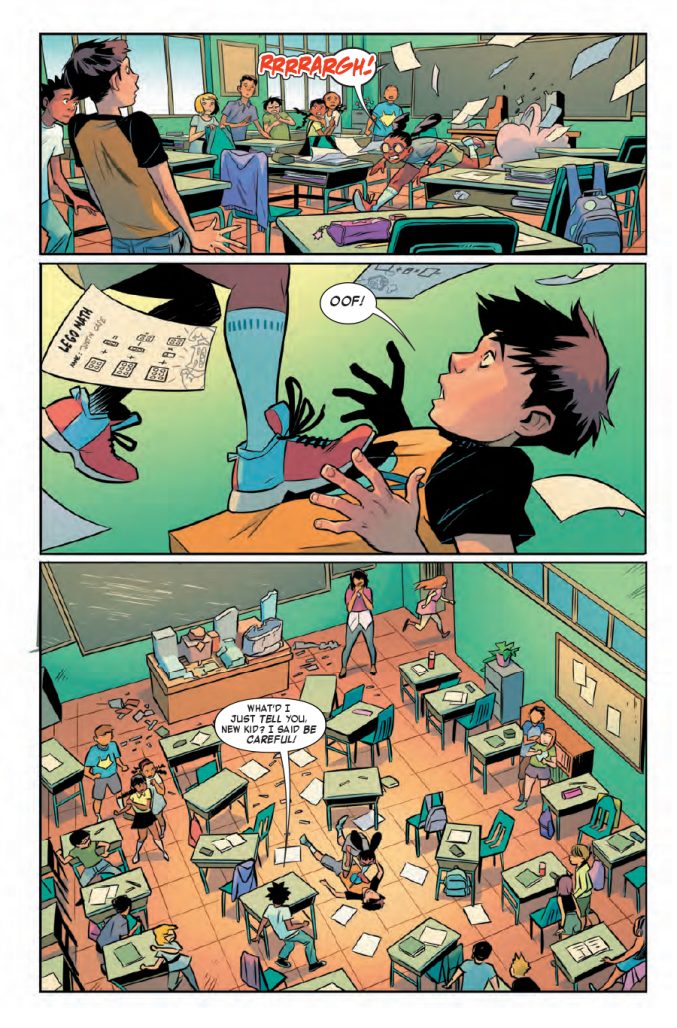
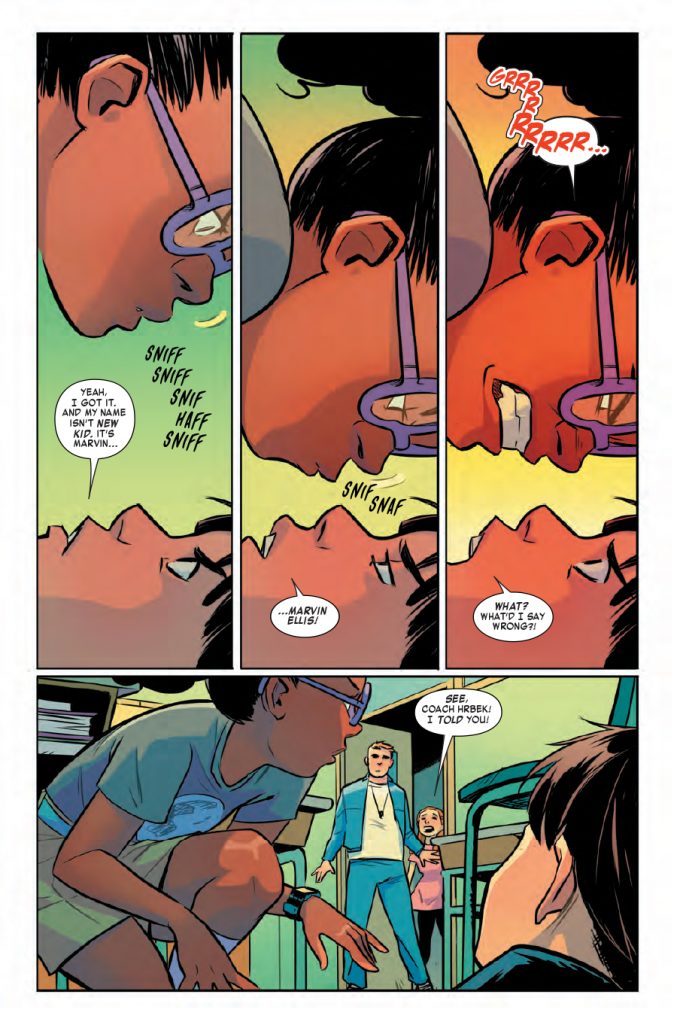
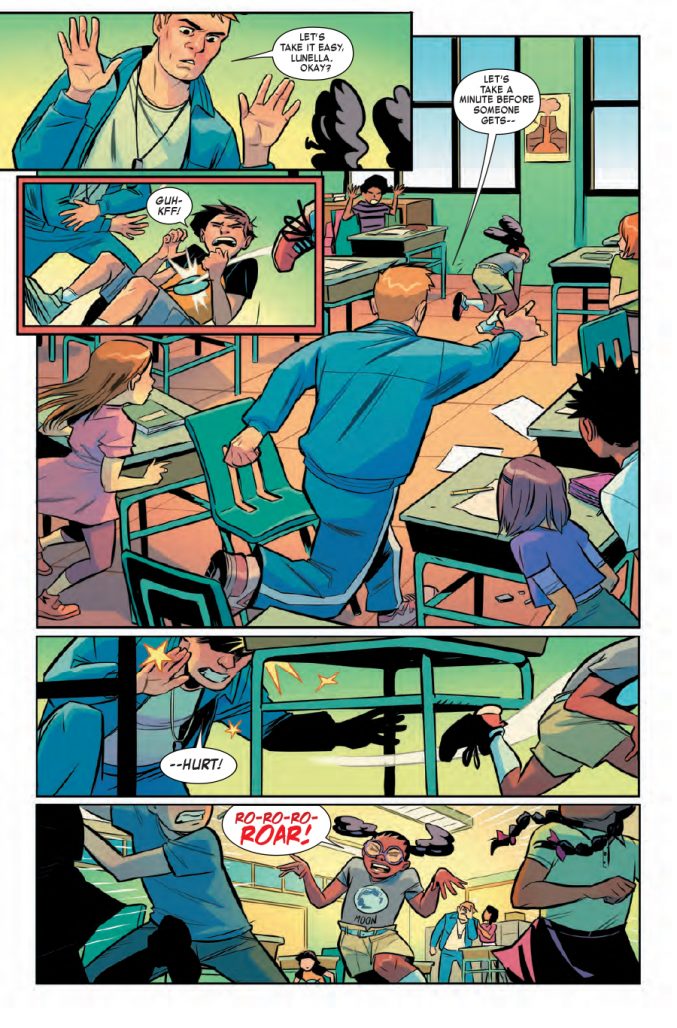






Thanks for this great interview
Spain has had a long established comic business. TBO was the first big seller. Then Cuto. Mortadilo and Filamon is known throughout the Spanish speaking world and don’t forget Zipi and Zape. Women like Purita Compos and Trini Trinidad have done comics for Britain and Germany. Also don’t forget Blacksad.
Comments are closed.